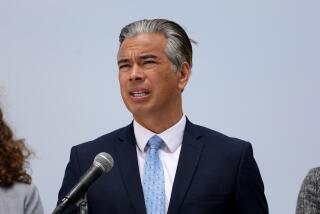Closing Arguments Begin in Marathon Toxic Exposure Case : Trial: More than 600 Lockheed workers contend they were injured because of inadequate health information.
- Share via
A lawyer for more than 600 Lockheed workers Tuesday accused the firm’s chemical suppliers of “despicable” conduct for concealing the risks of their products, as closing arguments began in the first phase of a marathon toxic exposure trial.
“I think they stink (for) what they did,” attorney Thomas V. Girardi told a Los Angeles Superior Court jury hearing the case against 20 chemical manufacturers and distributors.
“They had the ability all along to do the right thing, to give the right warnings, to make sure nobody got hurt by this stuff,” Girardi said.
Lawyers for the defendants--including petrochemical giants Exxon, DuPont, Shell and Arco--are expected to start their summations today.
The workers are seeking unspecified damages, contending that they suffered injuries because the chemical firms failed to provide adequate health risk information.
The case is a retrial of the suit that ended in a deadlock last spring after 12 weeks of jury deliberations, the longest deliberations in a civil case in U. S. history.
The dispute involves dozens of chemical products--including solvents, primers and epoxies--allegedly sold to Lockheed in the 1970s and ‘80s and used to build the Stealth fighter and other military aircraft.
Lawyers for the workers say warning labels shipped with chemicals, known as material safety data sheets, did not provide enough information about health risks and necessary safety precautions. As a result, they say, workers suffered maladies ranging from skin irritation to nervous system damage and cancer.
The chemical firms say they provided adequate warnings, and updated material safety data sheets as new information became available. Moreover, they contend, Lockheed is one of the world’s most sophisticated users of chemicals and was responsible for furnishing its workers adequate ventilation and protective equipment.
Formerly a defendant in the case, Lockheed was dismissed nearly two years ago after agreeing to pay a $33-million settlement. The settlement has not been disclosed to jurors to avoid influencing verdicts on the liability of the chemical firms.
Using a projector to display blowups of data sheets for specific chemicals, Girardi said the chemical firms soft-pedaled risks by stressing transitory effects of overexposure--such as skin and eye irritation--instead of permanent or life-threatening effects.
In several cases, he said, manufacturers neglected to state that epoxies containing asbestos or silica posed an inhalation risk, or failed to warn users not to create a breathing hazard by sanding the material.
In other cases, Girardi said, manufacturers eventually beefed up data sheets to include cancer warnings, but did so long after the risks became known.
*
According to Girardi, the policy was: “Until the last nail is driven in the toxicological coffin, we’re not going to warn about this stuff. . . . As a worker, you’d feel pretty tricked, pretty mad,” he said.
Now in their eighth week, the proceedings are but the first phase of a bifurcated trial. In the current phase, jurors merely will decide which chemical firms, if any, gave inadequate safety warnings and did so with knowledge that product users could be harmed.
If jurors find one or more firms liable, a second trial will determine if workers were actually exposed to their products and if injuries resulted from insufficient warnings.
In round two, jurors would consider the specific claims of 14 “pilot” plaintiffs, whose alleged injuries range from minor to severe.
The outcome could guide settlements with hundreds of the claimants, although more trials are possible.
More to Read
Inside the business of entertainment
The Wide Shot brings you news, analysis and insights on everything from streaming wars to production — and what it all means for the future.
You may occasionally receive promotional content from the Los Angeles Times.










